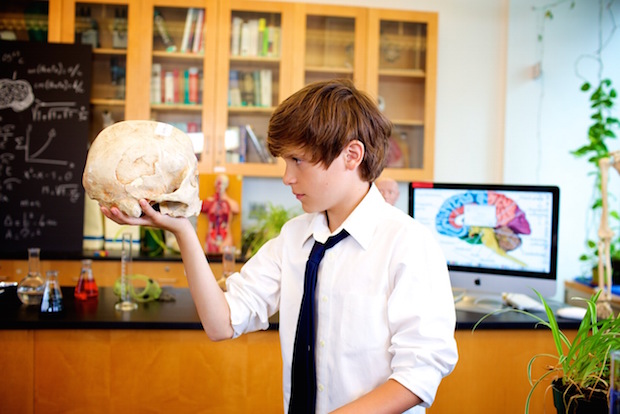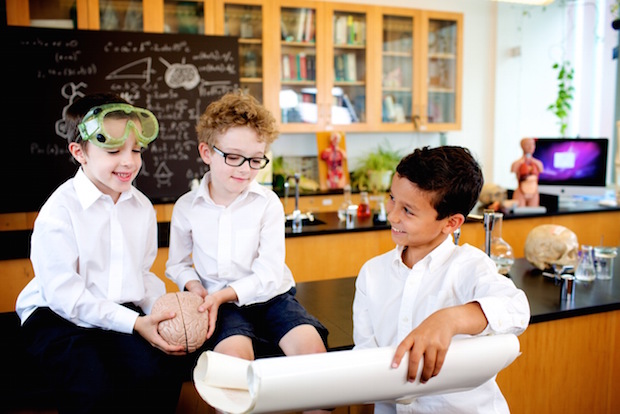There’s a place in your brain where the letter R lives. Everyone’s R-spot is pretty much the same, but they all operate in more than one way. That makes sense, because R is more than one letter. The French prefer their R on the back of the tongue, for example. Americans move theirs up to the middle, and the Spanish will not deign to pronounce an R at all unless they can balance it delicately on the tip of the tongue.
Letters that are expressed differently are also processed by the brain differently. So every little R—rolled or glottal or flattened or dropped altogether, as they are at the end of a word when the British get ahold of them—requires a particular bit of neural wiring. And that’s just one letter in an alphabet that has 25 others. That alphabet, in turn, is just one in a world with up to 19 more, to say nothing of the thousands of characters used by the Chinese, Japanese and other Asian cultures. And all of those letters produce hundreds of discrete phonemes that make up 6,800 discrete languages. On the day you were born, your brain was equipped to learn every single one of them—at least for a while.
“On the day you were born, your brain was equipped to learn every single one of the world’s 6800 or so languages—at least for a while.”
Learning a language is something we take for granted; nearly everyone is a completely fluent—if not terribly elegant—speaker of at least one native tongue by age five. But that’s not to say it’s easy on the brain. The act of thinking burns a lot of calories, and the brain, with one quadrillion synaptic connections to operate, takes more than its share. Even before we’re a year old, we start pruning back about one-third of the synaptic connections with which we’re born, making the brain a more focused, less diffuse organ, but also a more limited one. In the case of speech, that can also mean a monolingual one.

But what if we wedge that learning window open a little? What if we pour in two languages or even three or four while we can? Is being multilingual merely a nice marketable skill and a good way to make travel easier and foreign films more fun, or is the polyglot brain also a more nimble brain? Are there advantages to knowing more than one language that go beyond the utilitarian? Increasingly—indeed, overwhelmingly—scientists are saying yes, and those advantages extend to almost every area of your life
Studies are showing the multilingual people are cognitively more agile than monolinguals—able to toggle between non-linguistic tasks and problems with greater speed and ease. They focus better, deal with ambiguity better and understand symbolic systems like math and music better. Young, multilingual children may be more intuitive and empathic than monolingual kids, with a greater sense of the enormity and diversity of the world. Multilingual seniors tend to have a lower—or at least later—incidence of dementia than those who speak only one language.
“A life with an additional language is nothing short of a life with an additional dimension.”
For as long as humanity has been a lingual species, there has been at least anecdotal evidence for these advantages, but it was only when we developed the ability to peek into a working brain that we began to see the neural machinery at work. At the University of Washington in Seattle, for example, investigators use noninvasive magnetic encephalography to look for that elusive R spot in the brain—as well as the spots at which other discrete phonemes are translated and perceived.
The inability of many Asian cultures to distinguish between the R and L sounds may have been exaggerated—and, in a less sensitive era, made light of—in the popular culture, but it’s a very real thing. It is, however, just one of innumerable cases of cross-linguistic tone-deafness—sounds one culture comprehends and reproduces easily and others can’t begin to wrap their brains or tongues around. If you didn’t grow up in Italy, you could work the rest of your life to master the Italians’ particular gl blend and never get it right; ditto with the Castilian th or subtle overlap of the Spanish v and b. In all of these cases, it’s a question of the phonemes you hear before the brain-pruning begins.

In the Seattle lab, investigators illustrate this by monitoring the brains of native Japanese speakers when they hear the ba and wa sounds—which are phonemes that are common to most languages. The processing of both shows up as a precise dot in the brain—a sign of a well-trained cluster of highly specialized neurons that light up to register what the ears have heard. American brains react similarly to ba and wa, and they do the same when they hear an R or an L. But R’s and L’s have a much harder time in the Japanese brain. There, the discrete point becomes more of a diffuse splatter—a cluster of confused neurons recruiting other, surrounding neurons to see if they can make sense of what they’re hearing. After a certain age—which can come early in childhood—the brain will never get it right. The Japanese language, by pure random chance, never saw the need to incorporate those phonemes so the ears slammed shut to them.
“Multilingual people focus better, deal with ambiguity better and understand symbolic systems like math and music better.”
The average family does not have a magnetic encephalographer handy, but Lycée Français parents can see similar processes play out in their children all of the time. Our daughters are entering sixth and eighth grade in the fall, and have been LFNY students since pre-school. They were raised bilingually from birth with an English-speaking father and a Spanish-speaking mother. Their brains had clearly been primed for linguistic diversity, but neither had had a lick of French until the day they walked through the Lycée doors. They both picked up the new language well, but I noticed a subtle difference. Our younger daughter mastered the glottal R better and faster than our older daughter did, and even now, years later, still has a tiny edge in that small skill. The reason: the moment our older daughter began school, we all started moving through a more francophone world. We were surrounded by French speakers at parties, assemblies and school drop-offs. Although our younger daughter was only one year old at the time, she heard and absorbed it all.
“Linguistically,” wrote Patricia Kuhl, co-author of the book The Scientist in the Crib, “children start out as citizens of the world, but they don’t stay that way.” Maybe not, but the more they hear of other languages, the more they can grow up carrying the linguistic passports of at least a few other lands.
That pays big and often-unexpected dividends. At a multilingualism conference at the Lycée Français in 2012, research psychologist Ellen Bialystok of Toronto’s York University described what she called the common dog-chien problem, the challenge all bilingual people have of toggling between two words for every concept or object in their world. The challenge multiplies dramatically for tri- and quadri-lingual people. That takes brain muscle, but it also builds agility.

Dr. Bialystok cites studies in which monolinguals and bilinguals take the famous Stroop test, a simple exercise in which the names of colors are flashed on a screen with the words spelled out either in those same colors (red spelled out in red, for example) or in different colors (red spelled out in blue, or yellow spelled out in green). When everything matches up properly, the brain encounters no discordance. But when you flash a word and ask people to call out the different color of the ink they see and ignore what the word is saying to them, they require a moment’s extra processing. Bilinguals consistently perform faster and more accurately than monolinguals. While the Stroop test is hardly a task you’re called upon to perform in the ordinary course of your day, thousands of other things you do may well require such rapid-fire processing, and bilinguals do it better.
Sean Lynch, who, before becoming head of school at the Lycée Français worked in another multilingual school in France, sees subtler, more humanistic advantages to learning more than one language. Young children, by nature, are narcissists, which at their age is a perfectly appropriate developmental stage. He says that the sooner they develop a more outer-directed sense of the world, however, the sooner they learn empathy, cooperation and all of the other, higher qualities of a social species. In this sense, language is a great equalizer and humbler. If you don’t have a monopoly on even something as simple as what the word for toy or ball or puppy is—if you realize that there are 6,800 other options out there represented by 6,800 other human languages—it becomes awfully hard to persist in the idea that your world view is the best one, much less the only one, and that is a powerful and vital step to maturity.
“The sooner children develop a more outer-directed sense of the world, the sooner they learn empathy.”
Multilingualism does have an early, short-term cost. Bilingual parents and children regularly exhibit what linguistic scholars call code-switching and what the rest of us call the curse of Spanglish or Franglais—mixing two languages in a single sentence. Parents may do it for simplicity’s sake, trying to get an idea across to a child and choosing, cafeteria-style, the simplest words from both languages to do it. Kids both pick up that practice from their parents and come by it on their own, since they don’t always know the right word in the language they’re speaking at any one moment.
Code-switching does, briefly, lead to confusion, to smaller and less precise vocabularies in both languages than kids would have if they were specializing in just one. But over time the problem tends to sort itself out and the multilingual children catch up and become dually fluent.

And what of the late-life speakers? What of people who carry their prodigious language gifts with them to the age at which their other cognitive faculties begin falling? The hard truth is that nearly anyone who lives long enough will develop some form of dementia, whether it’s Alzheimer’s Disease or a milder variety. But the timing and severity of the conditions are not fixed and unchangeable. Dr. Bialystok cites studies in which bilinguals, on average, suffer the onset of age-related dementia 4.1 years later than monolinguals and full-blown Alzheimer’s 5.1 years later. Not everyone agrees that multilingualism alone can work that clarifying magic; it’s equally possible that any cognitive calisthenics, including adult education courses or merely working Sudoku puzzles can help. But others argue that multilingualism confers a benefit over and above all that.
That school of thought, according to Dr. Bialystok, “says the brains of multilinguals experience the same level of disease as monolinguals, but they cope with it better. They function at a higher level than they would otherwise be able to.”
For kids born straight into a two- or three-language household, multilingualism will come easily and automatically. For other kids, a bilingual school can provide a lift. And for parents—who struggle with homework in two or three languages, who sit through school assemblies picking up only the odd word from a tongue they may not speak, and, yes, who deal with the once-a-year sticker shock that comes from opening up the tuition bill—the road can be a long and hard one. But good things are rarely quick and easy. And great things—providing a child with cognitive, social and professional horizons that are far wider than they ever would have been otherwise—can make all of the toil and treasure worth it. A life with an additional language is nothing short of a life with an additional dimension.
Click here to read the story in the LFNY Magazine.
Photos by Pascal Kerbel.
About the Author :
Jeffrey Kluger is editor-at-large at Time Magazine and a parent at the Lycée Français de New York.

